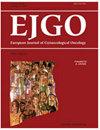鉴定免疫相关代谢基因标记以预测子宫内膜癌可能的预后并揭示免疫景观特征
IF 0.5
4区 医学
Q4 OBSTETRICS & GYNECOLOGY
引用次数: 0
摘要
子宫内膜癌的免疫治疗逐渐受到重视,代谢重编程与肿瘤免疫浸润有关。我们的目标是使用蛋白质组学分析来检查免疫相关代谢基因(irmg)在EC中的作用。数据独立采集质谱(DIA-MS)分析了20例EC患者,包括10例高级别癌组织和10例低级别癌组织。采用Spearman相关筛选irmg,并基于Cancer Genome atlas - Endometrioid Carcinoma (TCGA-UCEC)队列,采用最小绝对收缩和选择算子(LASSO)回归分析构建免疫相关代谢预后特征(IRMPS)。我们还研究了不同风险组在预后价值、临床效力、免疫特性和治疗反应方面的差异。共获得285个差异表达基因(deg)。随后,通过Spearman相关分析代谢- deg和免疫- deg,鉴定出41个irmg。最后,鉴定出NADH脱氢酶(泛素)1 α亚复合物亚基2 (NDUFA2)、AMPK-alpha2 (PRKAA2)、合成素结合蛋白1 (STXBP1)、NADH脱氢酶(泛素)1 β亚复合物亚基9 (NDUFB9)、核糖体蛋白s27样(RPS27L)、溶索磷脂酰基转移酶2 (LPCAT2)和尿苷单磷酸合成酶(UMPS)等7个irmg,以建立预后标志。风险评分被确定为独立的预后指标,irmps高组患者与EC的不良预后密切相关。此外,IRMPS与肿瘤免疫浸润密切相关。值得注意的是,irmps低组有更好的免疫检查点抑制剂(ICI)治疗反应,对化疗药物更敏感。综上所述,IRMPS可以作为一种精确的预后工具来指导EC患者的个性化治疗。本文章由计算机程序翻译,如有差异,请以英文原文为准。
Identification of an immune-related metabolic gene signature to predict possible prognosis in endometrial cancer and reveals immune landscape feature
The immunotherapy of endometrial cancer (EC) has gradually attracted attention and metabolic reprogramming is associate with tumor immune infiltration. Our goal was to use proteome analysis to examine the role of immune-related metabolic genes (IRMGs) in EC. Data-independent acquisition mass spectrometry (DIA-MS) was performed on 20 EC patients, consisting of 10 high-grade and 10 low-grade cancer tissues. IRMGs were screened using Spearman correlation, and an immune-related metabolic prognosis signature (IRMPS) was constructed based on the Cancer Genome Atlas-Uterine Corpus Endometrioid Carcinoma (TCGA-UCEC) cohort using the least absolute shrinkage and selection operator (LASSO) regression analysis. We also investigated differences between different risk groups in terms of prognostic value, clinical potency, immune characteristics and therapy response. In total, 285 differentially expressed genes (DEGs) were acquired via DIA-MS. Subsequently, metabolic-DEGs and immune-DEGs were analyzed by Spearman correlation to identify 41 IRMGs. Finally, seven IRMGs, including NADH dehydrogenase (ubiquinone) 1 alpha subcomplex subunit 2 (NDUFA2), AMPK-alpha2 (PRKAA2), syntaxin binding protein 1 (STXBP1), NADH dehydrogenase (ubiquinone) 1 beta subcomplex subunit 9 (NDUFB9), ribosomal protein S27-like (RPS27L), lysolecithin acyltransferase 2 (LPCAT2) and uridine monophosphate synthetase (UMPS) were identified to establish a prognosis signature. The risk score was determined as an independent prognostic indicator, and patients in the IRMPS-high group was strong linked with adverse prognosis for EC. Additionally, IRMPS was closely related with tumor immune infiltration. Notably, the IRMPS-low group had better immune checkpoint inhibitors (ICI) treatment response and more sensitive to chemotherapy drugs. In conclusion, IRMPS can serve as a precise prognostic tool to guide the personalized treatment of EC patients.
求助全文
通过发布文献求助,成功后即可免费获取论文全文。
去求助
来源期刊
自引率
25.00%
发文量
58
审稿时长
1 months
期刊介绍:
EJGO is dedicated to publishing editorial articles in the Distinguished Expert Series and original research papers, case reports, letters to the Editor, book reviews, and newsletters. The Journal was founded in 1980 the second gynaecologic oncology hyperspecialization Journal in the world. Its aim is the diffusion of scientific, clinical and practical progress, and knowledge in female neoplastic diseases in an interdisciplinary approach among gynaecologists, oncologists, radiotherapists, surgeons, chemotherapists, pathologists, epidemiologists, and so on.

 求助内容:
求助内容: 应助结果提醒方式:
应助结果提醒方式:


